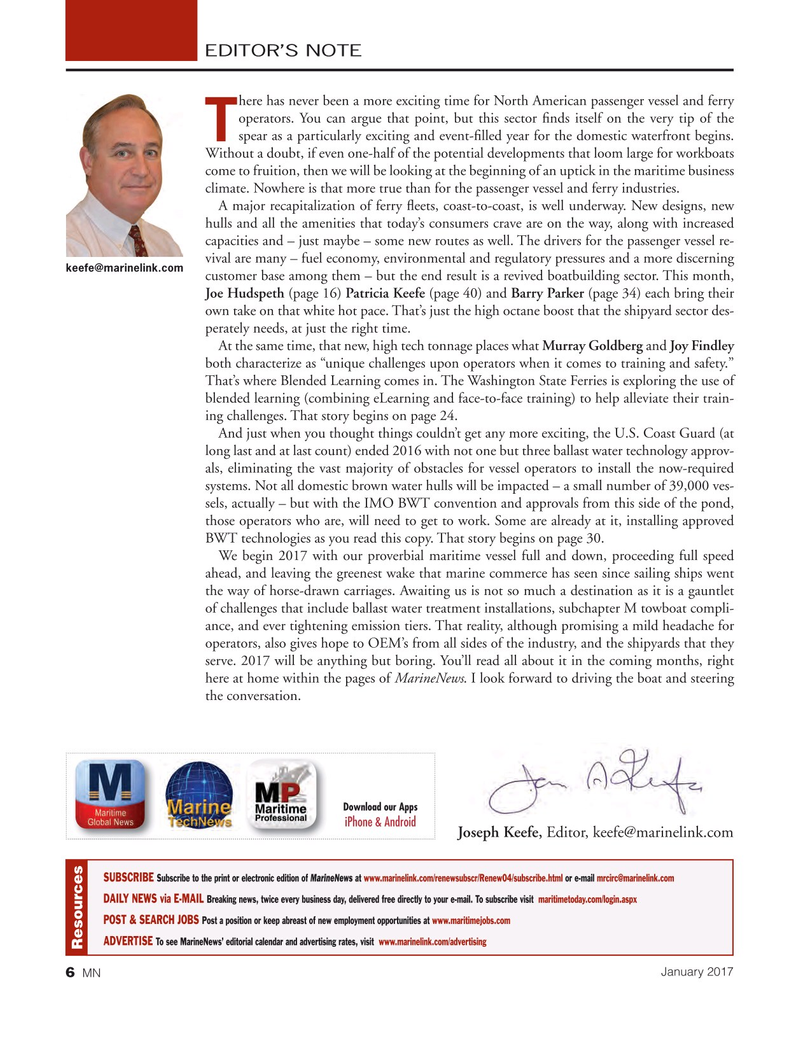
Page 6: of Marine News Magazine (January 2017)
Passenger Vessels & Ferries
Read this page in Pdf, Flash or Html5 edition of January 2017 Marine News Magazine
EDITOR’S NOTE here has never been a more exciting time for North American passenger vessel and ferry operators. You can argue that point, but this sector ? nds itself on the very tip of the spear as a particularly exciting and event-? lled year for the domestic waterfront begins.
T
Without a doubt, if even one-half of the potential developments that loom large for workboats come to fruition, then we will be looking at the beginning of an uptick in the maritime business climate. Nowhere is that more true than for the passenger vessel and ferry industries.
A major recapitalization of ferry ? eets, coast-to-coast, is well underway. New designs, new hulls and all the amenities that today’s consumers crave are on the way, along with increased capacities and – just maybe – some new routes as well. The drivers for the passenger vessel re- vival are many – fuel economy, environmental and regulatory pressures and a more discerning [email protected] customer base among them – but the end result is a revived boatbuilding sector. This month,
Joe Hudspeth (page 16) Patricia Keefe (page 40) and Barry Parker (page 34) each bring their own take on that white hot pace. That’s just the high octane boost that the shipyard sector des- perately needs, at just the right time.
At the same time, that new, high tech tonnage places what Murray Goldberg and Joy Findley both characterize as “unique challenges upon operators when it comes to training and safety.”
That’s where Blended Learning comes in. The Washington State Ferries is exploring the use of blended learning (combining eLearning and face-to-face training) to help alleviate their train- ing challenges. That story begins on page 24.
And just when you thought things couldn’t get any more exciting, the U.S. Coast Guard (at long last and at last count) ended 2016 with not one but three ballast water technology approv- als, eliminating the vast majority of obstacles for vessel operators to install the now-required systems. Not all domestic brown water hulls will be impacted – a small number of 39,000 ves- sels, actually – but with the IMO BWT convention and approvals from this side of the pond, those operators who are, will need to get to work. Some are already at it, installing approved
BWT technologies as you read this copy. That story begins on page 30.
We begin 2017 with our proverbial maritime vessel full and down, proceeding full speed ahead, and leaving the greenest wake that marine commerce has seen since sailing ships went the way of horse-drawn carriages. Awaiting us is not so much a destination as it is a gauntlet of challenges that include ballast water treatment installations, subchapter M towboat compli- ance, and ever tightening emission tiers. That reality, although promising a mild headache for operators, also gives hope to OEM’s from all sides of the industry, and the shipyards that they serve. 2017 will be anything but boring. You’ll read all about it in the coming months, right here at home within the pages of MarineNews. I look forward to driving the boat and steering the conversation.
Download our Apps iPhone & Android
Joseph Keefe, Editor, [email protected]
SUBSCRIBE Subscribe to the print or electronic edition of at www.marinelink.com/renewsubscr/Renew04/subscribe.html or e-mail [email protected]
DAILY NEWS via E-MAIL Breaking news, twice every business day, delivered free directly to your e-mail. To subscribe visit maritimetoday.com/login.aspx
POST & SEARCH JOBS
Post a position or keep abreast of new employment opportunities at www.maritimejobs.com
ADVERTISE
To see MarineNews’ editorial calendar and advertising rates, visit www.marinelink.com/advertising
Resources
January 2017 6 MN
MN Jan17 Layout 1-17.indd 6 MN Jan17 Layout 1-17.indd 6 1/5/2017 4:18:07 PM1/5/2017 4:18:07 PM

 5
5

 7
7
